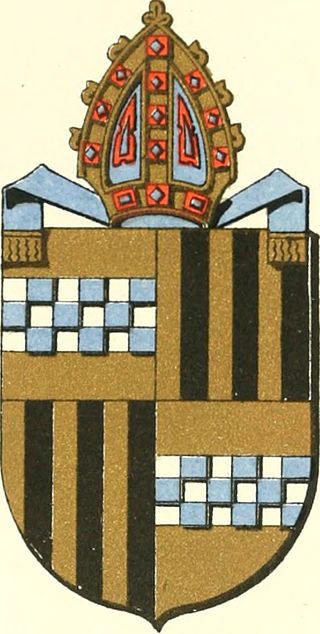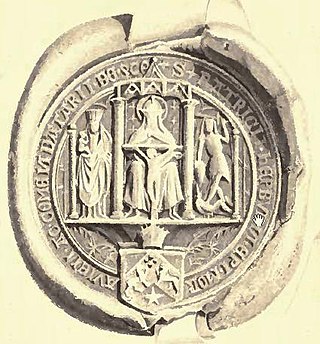Related Research Articles
Alexander or Alex Campbell may refer to:
George Brown was a late 15th-century and early 16th-century Scottish churchman. He first appears on record in 1478 as the rector of the church of Tyningham, and is called a clerk of the diocese of Brechin. In 1482, he was selected to be Chancellor of the diocese of Aberdeen.

Andrew Stewart was a 16th-century Scottish noble and cleric. He was a legitimate son of John Stewart, 1st Earl of Atholl and Eleanor Sinclair, daughter of William Sinclair, Earl of Orkney. His paternal grandmother was Joan Beaufort, former queen-consort of Scotland. Andrew chose an ecclesiastical career, held a canonry in Dunkeld Cathedral and was rector of Blair parish church, a church under the control of the earls of Atholl.
Donald Campbell was a 16th-century Scottish noble and churchman. He was the son of Archibald Campbell, 2nd Earl of Argyll and Elizabeth Stewart, daughter of John Stewart, 1st Earl of Lennox. From 1522, he was a student of St Salvator's College, at the University of St Andrews. After graduation, he became a cleric in his home diocese, the diocese of Argyll.
James Paton was a 16th-century Scottish cleric from Ballilisk, an estate in the parish of Muckhart, west of Kinross. As Ballilisk appears to have been a rectory serving the adjacent chapel at Muckhart his family are presumed to have included priests who served the parish in Pre-Reformation days.
Peter Blackburn (d.1616) was a Scottish scholar and prelate. He was the second Protestant Bishop of Aberdeen.

Andrew Stewart was a 15th-century Scottish prelate and administrator.

Patrick Hepburn was a 16th-century Scottish prelate. He served as both pre- and post-Reformation Bishop of Moray.
Thomas de Dundee, also called Thomas Nicholay, was a Scottish prelate who held the bishopric of Ross during the First War of Scottish Independence. Coming from a family of Dundee burgesses, he was educated as the University of Bologna, before entering into career in the church.

Albin was a 13th-century prelate of the Kingdom of Scotland. A university graduate, Albin is known for his ecclesiastical career in the diocese of Brechin, centred on Angus in east-central Scotland.
Laurence de Ergadia was a thirteenth-century Scottish bishop. Probably from the MacDougall kindred of Argyll, Laurence had become a Dominican friar and presumably university graduate before being elected Bishop of Argyll, an election which took place sometime between 1262 and 1264. Although the election was quashed by the Pope in 1264, the Pope gave him a fresh provision to the bishopric. Laurence appears intermittently in the records during his three and a half decade episcopate, but his activities in his own diocese are badly recorded. He died as Bishop of Argyll sometime in either 1299 or 1300.
William de Cambuslang was a 14th-century Scottish churchman, presumably coming from a family based at or originating from Cambuslang near Glasgow.
John Spalding was a 15th-century churchman based at Brechin in Angus, Scotland. Spalding became Dean of Brechin in 1456; he was confirmed in this position by the Pope on 5 October 1458.
Neil Campbell was the son of Alexander, son of the parson [MacPherson], a member of the Campbells of Carnassarie.
Séon Carsuel was a 16th-century Scottish prelate, humanist, and Protestant reformer. Born early in the century, when Carsuel completed his education he joined the service of the Protestant Earl of Argyll, tutoring his son and using his patronage to obtain benefices, most notably becoming Bishop of the Isles in 1565. Standing at over 7 feet in height, Carsuel was an important figure in the history of Scottish Gaelic, as in 1567 his Foirm na n-Urrnuidheadh, the Gaelic translation of the Book of Common Order, became the first work to be printed in any Goidelic language.
David Lindsay was a Church of Scotland minister and prelate active in the seventeenth-century.
The Archdeacon of Brechin was the only archdeacon in the diocese of Brechin, acting as a subordinate of the Bishop of Brechin. The archdeacon held the parish church of Strachan as a prebend from at least 1274.
The Archdeacon of Argyll was the only archdeacon in the diocese of Argyll, acting as a subordinate of the Bishop of Argyll. Regarding his supporting churches, it is known that archdeacon held a quarter of parish church of Eilean Munde as a prebend.
The Archdeacon of the Isles was the only archdeacon in the diocese of the Isles, acting as a subordinate of the Bishop of the Isles. The number and names of the prebends, if any, associated with the archdeaconry in the later Middle Ages are not known. Before the break-away of the diocese of Man during the Western Schism, the archdeacons held Kirk Andreas as a prebend. The office seems to have fallen into disuse after the time of Alasdair Caimbeul, who received crown presentation to the position in 1592. It was to be revived in 1662.
John de Crannach was a 15th-century Scottish scholar, diplomat and prelate. Originating in the north-east of Lowland Scotland, he probably came from a family associated with the burgh of Aberdeen. Like many of his relatives, he flourished in the 15th-century Scottish church. After just over a decade at the University of Paris, Crannach became a servant of the then Dauphin Charles (VII).
References
- Keith, Robert (1824), An Historical Catalogue of the Scottish Bishops: Down to the Year 1688 (New ed.), London
- MacDonald, Alan R. (2004), "Campbell, Alexander, of Carco (d. 1608)", Oxford Dictionary of National Biography, Oxford: Oxford University Press
- edited by D.E.R. Watt and A.L. Murray. (2003), Watt, D. E. R.; Murray, A. L. (eds.), Fasti Ecclesiae Scoticanae Medii Aevi ad annum 1638, The Scottish Record Society, New Series, Volume 25 (Revised ed.), Edinburgh: The Scottish Record Society, ISBN 0-902054-19-8, ISSN 0143-9448, OCLC 186075005
{{citation}}:|author=has generic name (help)